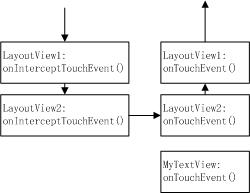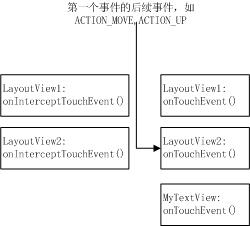Android中的事件类型分为按键事件和屏幕触摸事件,Touch事件是屏幕触摸事件的基础事件,有必要对它进行深入的了解。
一个最简单的屏幕触摸动作触发了一系列Touch事件:ACTION_DOWN->ACTION_MOVE->ACTION_MOVE->ACTION_MOVE…->ACTION_MOVE->ACTION_UP
当屏幕中包含一个ViewGroup,而这个ViewGroup又包含一个子view,这个时候android系统如何处理Touch事件呢?到底是
ViewGroup来处理Touch事件,还是子view来处理Touch事件呢?我只能很肯定的对你说不一定。呵呵,为什么呢?看看下面我的调查结果你
就明白了。
android系统中的每个View的子类都具有下面三个和TouchEvent处理密切相关的方法:
1)public booleandispatchTouchEvent(MotionEvent ev) 这个方法用来分发TouchEvent
2)public boolean onInterceptTouchEvent(MotionEvent ev)这个方法用来拦截TouchEvent
3)public boolean onTouchEvent(MotionEvent ev)这个方法用来处理TouchEvent
当TouchEvent发生时,首先Activity将TouchEvent传递给最顶层的View,
TouchEvent最先到达最顶层 view的 dispatchTouchEvent,然后由 dispatchTouchEvent方法进行分发,
如果dispatchTouchEvent返回true,则交给这个view的onTouchEvent处理,
如果 dispatchTouchEvent返回 false,则交给这个 view的 interceptTouchEvent方法来决定是否要拦截这个事件,
如果 interceptTouchEvent返回 true,也就是拦截掉了,则交给它的onTouchEvent来处理,
如果 interceptTouchEvent返回 false,那么就传递给子 view,由子 view 的dispatchTouchEvent再来开始这个事件的分发。
如果事件传递到某一层的子 view的 onTouchEvent上了,这个方法返回了 false,那么这个事件会从这个 view往上传递,都是onTouchEvent来接收。
如果事件传递到某一层的子view的onTouchEvent上了,这个方法返回false,那么这个事件将不会向上传递了,又这个view拦截处理.
而如果传递到最上面的 onTouchEvent也返回 false的话,这个事件就会“消失”,而且接收不到下一次事件
onInterceptTouchEvent()用于处理事件并改变事件的传递方向。处理事件这个不用说了,你在函数内部编写代码处理就可以了。而决定传递方向的是返回值,返回为false时事件会传递给子控件的onInterceptTouchEvent();返回值为true时事件会传递给当前控件的onTouchEvent(),而不在传递给子控件,这就是所谓的Intercept(截断)。
onTouchEvent() 用于处理事件,返回值决定当前控件是否消费(consume)了这个事件。可能你要问是否消费了又区别吗,反正我已经针对事件编写了处理代码?答案是有区别!比如ACTION_MOVE或者ACTION_UP发生的前提是一定曾经发生了ACTION_DOWN,如果你没有消费ACTION_DOWN,那么系统会认为ACTION_DOWN没有发生过,所以ACTION_MOVE或者ACTION_UP就不能被捕获。
本文源地址:http://www.cnblogs.com/rocky_yi/archive/2011/01/21/1941522.html# ,转载请注明出处!
<com.touchstudy.LayoutView1 xmlns:android=”http://schemas.android.com/apk/res/android”
android:orientation=”vertical”
android:layout_width=”fill_parent”
android:layout_height=”fill_parent” >
<com.touchstudy.LayoutView2
android:orientation=”vertical”
android:layout_width=”fill_parent”
android:layout_height=”fill_parent”
android:gravity=”center”>
<com.touchstudy.MyTextView
android:layout_width=”wrap_content”
android:layout_height=”wrap_content”
android:id=”@+id/tv”
android:text=”AB”
android:textSize=”40sp”
android:textStyle=”bold”
android:background=”#FFFFFF”
android:textColor=”#0000FF”/>
</com.touchstudy.LayoutView2>
</com.touchstudy.LayoutView1>
在没有重写onInterceptTouchEvent()和onTouchEvent()的情况下(他们的返回值都是false), 对上面这个布局,MotionEvent事件的传递顺序如下:
当某个控件的onInterceptTouchEvent()返回值为true时,就会发生截断,事件被传到当前控件的onTouchEvent()。如我们将LayoutView2的onInterceptTouchEvent()返回值为true,则传递流程变成:
如果我们同时将LayoutView2的onInterceptTouchEvent()和onTouchEvent()设置成true,那么LayoutView2将消费被传递的事件,同时后续事件(如跟着ACTION_DOWN的ACTION_MOVE或者ACTION_UP)会直接传给LayoutView2的onTouchEvent(),不传给其他任何控件的任何函数。同时传递给子空间一个ACTION_CANCEL事件。传递流程变成(图中没有画出ACTION_CANCEL事件):

附SDK给出的说明:
关注微信公众号,最新技术实时推送


转载请注明:尼古拉斯.赵四 » Android中父View和子view的点击事件的执行过程



